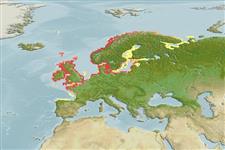Environment: milieu / climate zone / depth range / distribution range
Ökologie
seewasser; brackwasser benthopelagisch; standorttreu; tiefenbereich 1 - 6 m (Ref. 130221). Temperate; 71°N - 43°N, 11°W - 55°E
Northeast Atlantic: north-western Europe.
Size / Gewicht / Alter
Maturity: Lm ? range ? - ? cm
Max length : 22.0 cm SL Männchen/unbestimmt; (Ref. 4119)
Rückenflossenstacheln (insgesamt) : 14 - 17. Front of body brassy-yellow in the male, with larger pectoral fins than in the female (Ref. 35388).
Adults live solitary or in pairs in weedy, shallow coastal areas (Ref. 4119). Feed on small invertebrates (Ref. 4119). Males build a nest from algae and debris, using kidney excrete as glue. Spawning season is May to June. Females deposit 150 - 200 eggs in the nest and often die shortly afterwards (Ref. 9900). Males care for and defend the nest. Offsprings reach maturity in one year (Ref. 4645).
Males build, guard and aerate the nest where the eggs are deposited (Ref. 205). Also Ref. 53335.
Muus, B.J. and P. Dahlström, 1974. Collins guide to the sea fishes of Britain and North-Western Europe. Collins, London, UK. 244 p. (Ref. 173)
IUCN Rote Liste Status (Ref. 130435: Version 2024-2)
Bedrohung für Menschen
Harmless
Nutzung durch Menschen
Fischereien: nicht kommerziell
Tools
Zusatzinformationen
Download XML
Internet Quellen
Estimates based on models
Preferred temperature (Ref.
123201): 7.5 - 12.5, mean 9.9 °C (based on 512 cells).
Phylogenetic diversity index (Ref.
82804): PD
50 = 1.0000 [Uniqueness, from 0.5 = low to 2.0 = high].
Bayesian length-weight: a=0.00468 (0.00204 - 0.01073), b=3.05 (2.84 - 3.26), in cm total length, based on LWR estimates for this (Sub)family-body shape (Ref.
93245).
Trophic level (Ref.
69278): 3.5 ±0.37 se; based on food items.
Widerstandsfähigkeit (Ref.
120179): hoch, Verdopplung der Population dauert weniger als 15 Monate. (K=1.78; tm=1).
Fishing Vulnerability (Ref.
59153): Low vulnerability (17 of 100).
Nutrients (Ref.
124155): Calcium = 35 [8, 105] mg/100g; Iron = 0.37 [0.14, 1.25] mg/100g; Protein = 2.67 [0.00, 6.47] %; Omega3 = 0.522 [0.226, 1.292] g/100g; Selenium = 9.45 [1.54, 29.35] μg/100g; VitaminA = 19.8 [6.0, 61.4] μg/100g; Zinc = 0.842 [0.413, 1.601] mg/100g (wet weight);
